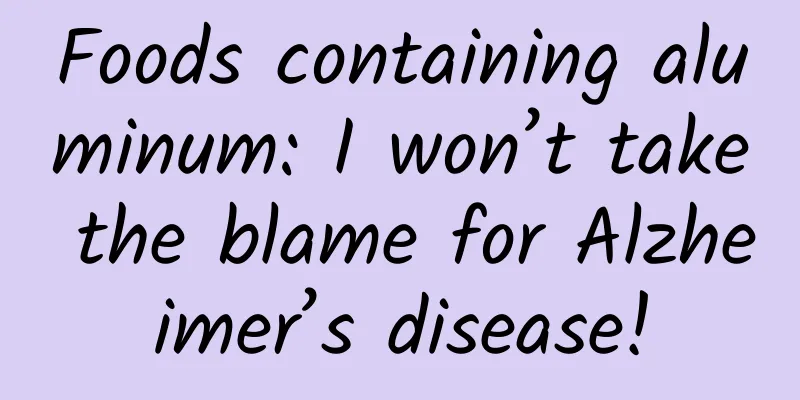Foods containing aluminum: I won’t take the blame for Alzheimer’s disease!

|
Will eating foods containing aluminum cause Alzheimer's disease? In the 1960s and 1970s, Canadian doctors found that the aluminum ion content was higher than that of normal people when they tested the brains of several Alzheimer's (AD) patients. Subsequently, they published a report that aluminum is a harmful element and is related to Alzheimer's disease. The release of this report attracted the attention of the medical community around the world at the time, and gradually spread, receiving attention from all walks of life around the world. As a result, well-informed people in China took the lead in smashing their aluminum lunch boxes, aluminum pots, and aluminum kettles at home and replacing them with stainless steel ones. Gradually, people in society heard that aluminum can induce Alzheimer's disease. However, one of the most important criteria for scientific research is experimental repeatability. Some medical professionals conducted repeated experiments on the Canadian doctor's report. The results showed that the measurement of aluminum content in the brains of AD deceased people contacted by Canadian doctors did not repeat the experimental results reported previously. In other words, they did not find any significant increase in aluminum content in the brain tissue of the deceased. Later, it was discovered that the samples taken by Canadian doctors during the pathological autopsy of the deceased's brain were stored in aluminum boxes and put in the refrigerator waiting for testing. It may be during this process that the brain samples of the deceased were contaminated by the aluminum boxes. In 2008, the European Food Safety Authority conducted a risk assessment on aluminum in the diet and concluded that based on the available evidence, aluminum intake from food is not considered to pose a risk of causing Alzheimer's disease. Alum: I am not an “illegal additive” When talking about aluminum, we have to mention alum, whose scientific name is "potassium aluminum sulfate dodecahydrate". When it comes to alum, many people's first reaction is "illegal additive". (Copyrighted image from the gallery, no permission to reprint) First of all, it should be noted that alum is not absolutely forbidden to be added to food, and the quality of some foods can indeed be improved by adding alum. Studies have shown that the quality of vermicelli with and without alum is very different. Just adding 0.3% alum to vermicelli can improve the breakage of vermicelli, and adding 0.4% can make the quality of sweet potato vermicelli reach the best. Therefore, alum can be added to food as a leavening agent, but it must comply with the provisions of "GB2760-2014 Use of Food Additives". The national standard stipulates that alum can be added to bean products, batter, fried noodle products, shrimp-flavored chips, and baked foods, and the aluminum residue must be ≤100mg/kg; alum can also be added to pickled jellyfish, and the aluminum residue must be ≤500mg/kg. In other words, alum is a legal food additive. However, if it is added excessively, resulting in a high aluminum residue, it will endanger human health. The hazards of excessive aluminum intake Although current research cannot conclude that aluminum can cause Alzheimer's disease, and aluminum will not cause acute poisoning in the human body, if the aluminum intake exceeds the standard, it will still cause certain harm to the human body. This is because only 10% to 15% of aluminum ingested by the human body can be excreted out of the body, and most of it will accumulate in the body, combining with various important components of the human body such as proteins and enzymes, affecting various biochemical reactions in the body. The U.S. Food and Drug Administration has determined that it is safe to ingest 5 μg of aluminum per kilogram of body weight per day. Long-term intake will have a certain impact on calcium ion homeostasis and other active elements, and will have a certain toxicity to the liver, kidneys, bones, and nerves. Therefore, to live a healthy life, it is important to avoid excessive intake of aluminum. First of all, you should eat a balanced diet and eat less foods with high aluminum content. Try to eat less fried dough sticks, fried cakes, baked foods, puffed foods, etc. Secondly, you should pay attention to the combination. For example, when eating foods with high aluminum content such as fried dough sticks, pairing them with vegetables and whole grains can interfere with the absorption of aluminum. In addition, when purchasing packaged foods, look carefully at the ingredient list and try to choose foods that do not contain aluminum additives; We should also try to minimize the use of aluminum utensils and aluminum foil. When using them, avoid using them to hold acidic foods, such as tomatoes, vinegar, etc., to prevent the precipitation of aluminum. |
Recommend
Can't understand the blood test results? Just grasp these four core items
When you go to the hospital for a cold or fever, ...
"Fibble" TV version experience: Fatty, do your family members know that you are so flexible?
Although the 3D TV game "Fibble" indepe...
Ipad illustration course for students will be completed in May 2021 [HD quality with brush materials]
Ipad illustration course for students will be com...
How did modern humans “climb onto” the Qinghai-Tibet Plateau? A gift from the Denisovans
Produced by: Science Popularization China Author:...
Android development SMS verification code example
Before talking about the knowledge point of SMS v...
Electric Technology Car News: Exquisite appearance and perfect endurance, this electric car brings hope to the EV industry
It is said that young people like to follow fashi...
Changsha tea tasting, Hi Select Club, where is the most reliable place to drink tea
Recommended 185-6916-1745 Wei QQ synchronization,...
How much does it cost to join a lottery app in Fuyang?
How much does it cost to join a lottery app in Fu...
Will this small step for Miaopai be a big step for short videos?
It is extremely difficult to find some irrelevant...
A Tibet Airlines flight went off the runway and caught fire! What is the "black ten minutes"? How to respond to an airplane accident?
At about 8:00 on May 12, a Tibet Airlines flight ...
Is the investment promotion fee for Tongchuan Real Estate Mini Program high? Tongchuan Real Estate Mini Program Investment Fees and Process
How much is the investment price in Tongchuan Rea...
Faraday Future Financial Report: Faraday Future's full-year operating loss in 2024 narrowed by 47.7% year-on-year to US$149.7 million
Recently, Faraday Future (NASDAQ: FFAI, FF for sh...
Wearing a mask for a long time can cause lung nodules to grow larger? Don't believe these rumors
The weather will become colder when the Earth rea...
What happened to Trump's announcement that he would stop funding the World Health Organization? What is the specific situation?
At a critical moment, Trump said he would stop fu...
Detailed explanation of the new business model of customer acquisition in 2020: the competition for stock, closed loop of traffic...
Advertising is a barometer of economic developmen...









